#anti Zutara
Explore tagged Tumblr posts
Text
Zutara shippers only see Katara as a trophy for Zuko’s redemption. It says a lot about the ship that in order for it to make sense they have to completely ruin Kataras character. I know you weren’t able to live out your high school fantasies with the emo kid in class but damn. Stop ruining a REAL strong female character with your self-insert bullshit. I like Zuko, but Katara deserves more than being a trophy for his redemption.
22 notes
·
View notes
Text
I love Zutara as much as the next girlie, but I think people romanticizing Zuko catching Azula's lightning in the Final Agni Kai are doing Zuko's character a massive disservice. He would have done that for anyone. Not just anyone in the Gaang, anyone.
He did it for the division he ended up getting burned over. He did it for his subordinate that was going to fall to his death after the ship was struck by lightning. He did it for Lee, when he was kidnapped by Gao. He did it for Iroh, when he confronted his dad and tried to break him out of prison. He did it for the whole Gaang at the Western Air Temple. He did it for Sokka, Suki, and Hakoda at the Boiling Rock.
His whole character revolves around saving everyone else first. Hell, he tried to save Zhao of all people! There's no way that would have gone well for Zuko if Zhao had actually taken his hand. He always does what he thinks is right first before considering his own safety.
Zuko always saves other people. Even if, especially if, he can't save himself.
#look i love zutara#but zuko has no conception of personal safety#there are better zutara moments in atla!!!!#like i will absolutely still read fanfic that romanticizes that scene#but it still would have happened if literally anyone else had been standing there#zutara#zutara criticism#i'm going to tag this as#anti zutara#just in case someone doesn't want to see a critique of the ship#i'm not really critiquing the ship#but out of an abundance of caution#uh actual antis if you see this: behave yourselves lol#zuko#avatar the last airbender#atla
5K notes
·
View notes
Text
I think that one of the reasons I hate zutara and I like zukka is because the zukka fandom is pretty much the opposite of the zutara fandom.
I've never ever seen a post where someone tries to prove that zukka should've been canon or that it IS canon. Zutara shippers take every scene between the two and over analyze everything to the point that it's exhausting and annoying.
Zukka shippers don't do that, and most of the fandom is just like, "Haha, what if these two kissed?" And honestly, I love that sm more than the over analyzing
2K notes
·
View notes
Text
I find it so funny that Zutaras, for generations, wrote entire think pieces about how Mai is:
1. Too Apolitical and apathetic to be a Firelady
2. Completely selfish and always acting in her own best interest
3. Would only hinder Zuko’s progress as a Firelord
All in attempt to diminish her character and try and prove Katara of all people would be a better Firelady.
Now we have CANON to confirm that Mai is fearless and a staunch advocate for undoing years of fire nation propaganda. And that she’s willing to drop everything to help Zuko in a noble cause - including teaching a new generation of kids the truth about the hundred year war.
Suck. On. That.

#anti zutara#anti zutara Stan’s#firelady mai#mai#zuko#maiko#avatar the last airbender#atla maiko#maikingsenseofit#FIRELADY#KATARA NEVER MADE SENDE
729 notes
·
View notes
Text
They way certain people here want Katara to be a woman with no agency over her life and marriage, miserable, unhappy, abused and used as an incubator by the evil monk Aang....so sad.
She's a hero, powerful, the master of water bending, in love and happy :) And she’s loved and respected by Aang
If she was unhappy with Aang, she would have dropped his ass in 0.5 seconds. Yes the real Katara can do that, unlike your cinderella self insert
You all reducing one of the strongest, most interesting, and dynamically written characters in the show to misogynistic tropes and theories just because you don't like the boy she ended up with. You are literally making up things to be mad about. This is hilarious
Well you can stay mad forever lol

1K notes
·
View notes
Text

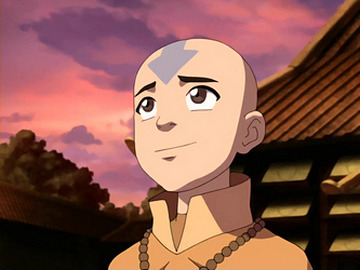
save me characters who are still hated and mischaracterized in 2024 for the sake of a fanon ship save meeeee
2K notes
·
View notes
Text
“Aang’s shorter than Katara-“
Jokes on you dude. Their in-show height diff makes it 10000000x cuter than it already is. Find a new argument or maybe get a life idk








Kataang height difference is sacred and if you don’t think so then just know that it’s ok to be wrong <3
446 notes
·
View notes
Text
Hey so can we like stop with the "Zutara is for the girls and Kataang is for the boys" thing. It's silly and it's breakdancing just on the edge of gender essentialism.
The assumption that there is something inherent to Zutara that appeals predominantly to women and Kataang that appeals predominantly to men is dishonest because every ship can have appeal to all genders.
The discussion of the "female gaze" in Zutara and the "male gaze" in Kataang is also redundant. I enjoy dissecting the concept of "the gaze", however it is important to note that the "female gaze" doesn't have a set definition or grouping of conventions it adheres to. Lisa French, Dean of RMIT University’s School of Media and Communication says:
“The female gaze is not homogeneous, singular or monolithic, and it will necessarily take many forms... The aesthetic approaches, experiences and films of women directors are as diverse as their individual life situations and the cultures in which they live. The "female' gaze” is not intended here'to denote a singular concept. There' are many gazes."
Now excuse me as I put on my pretentious humanistics student hat.
Kataang's appeal to women and the female gaze
Before I start, I want to note that the female gaze is still a developing concept
There are very few female film directors and writers, and most of them are white. The wants and desires of women of colour, the demographic Katara falls into, are still wildly underepresented. Additionally, the concept of the female gaze had many facets, due to it being more focused on emotional connections rather than physical appearance as the male gaze usually is. Which means that multiple male archetypes fall into the category of "for the female gaze".
The "female gaze" can be best described as a response to the "male gaze", which was first introduced by Laura Mulvey in her paper: "Visual Pleasure and Narrative Cinema" , however the term "male gaze" itself was not used in the paper.
Mulvey brought up the concept of the female character and form as the passive, objectified subject to the active voyeuristic male gaze, which the audience is encouraged to identify, usually through the male character.
To quote her:
"In a world ordered by sexual imbalance', pleasure' in looking has been split between active'/male' and passive/female'. The determining male gaze' projects its fantasy onto the female' figure', which is styled accordingly."
Mulvey also brings up the concept of scopopfillia (the term being introduced by Freud), the concept of deriving sexual gratification from both looking and being looked at. This concept has strong overtones of voyeurism, exhibitionism and narcissism, placing forth the idea that these overtones are what keeps the male viewer invested. That he is able to project onto the male character, therefore being also able to possess the passive female love interest.
However, it's important to note that Mulvey's essay is very much a product of its times, focused on the white, heterosexual and cisgender cinema of her time. She also drew a lot of inspiration from Freud's questionable work, including ye ole penis envy. Mulvey's paper was groundbreaking at the time, but we can't ignore how it reinforces the gender binary and of course doesn't touch on the way POC, particularly women of colour are represented in film.
In her paper, Mulvey fails to consider anyone who isn't a white, cis, heterosexual man or woman. With how underrepresented voices of minorities already are both in media and everyday life, this is something that we need to remember and strive to correct.
Additionally Mulvey often falls into gender essentialism, which I previously mentioned at the beginning of this post. Funny how that keeps coming up
"Visual Pleasure and Narrative Cinema" started a very interesting and important conversation, and I will still be drawing from certain parts of it, however huge swathes of this text have already become near archaic, as our culture and relationship with media evolves at an incredible pace.
And as filmaking evolves, so does our definition of the male and female gaze. So let's see what contemporary filmakers say of it.
In 2016, in her speech during the Toronto International Film Festival , producer of the TV series Transparent, Jill Soloway says:
“Numero uno, I think the Female Gaze is a way of “feeling seeing”. It could be thought of as a subjective camera that attempts to get inside the protagonist, especially when the protagonist is not a Chismale. It uses the frame to share and evoke a feeling of being in feeling, rather than seeing – the characters. I take the camera and I say, hey, audience, I’m not just showing you this thing, I want you to really feel with me.
[Chismale is Soloway's nickname for cis males btw]
So the term "female gaze" is a bit of a misnomer, since it aims to focus on capturing the feelings of characters of all genders. It's becoming more of a new way of telling stories in film, rather than a way to cater to what white, cisgender, heterosexual women might find attractive in a man.
Now, Aang is the decided protagonist of the show, however, Atla having somewhat of an ensemble cast leads to the perspective shifting between different characters.
In the first episode of atla, we very much see Katara's perspective of Aang. She sees him trapped in the iceberg, and we immediately see her altruism and headstrong nature. After she frees Aang, we are very much first subjected to Katara's first impressions of him, as we are introduced to his character. We only see a sliver of Aang's perspective of her, Katara being the first thing he sees upon waking up.
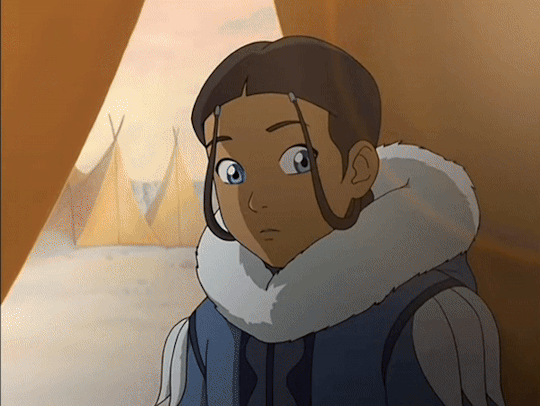
We see that she is intrigued and curious of him, and very excited about his presence. She is endeared and amused by his antics. She is rediscovering her childish side with his help. She is confiding in him about her own trauma surrounding the Fire Nation's genocide of the Southern Waterbenders. She is willing to go against her family and tribe ans leave them behind to go to the Northern Water Tribe with Aang. We also see her determination to save him when he is captured.
As the show moves on and the plot kicks into gear, we do shift more into Aang's perspective. We see his physical attraction to her, and while we don't see Katara's attraction quite as blatantly, there are hints of her interest in his appearance.

This is where we get deeper into the concept of Aang and Katara's mutual interest and attraction for one another. While her perspective is more subtle than most would like, Katara is not purely an object of Aang's desire, no more than he is purely an object of her desire.
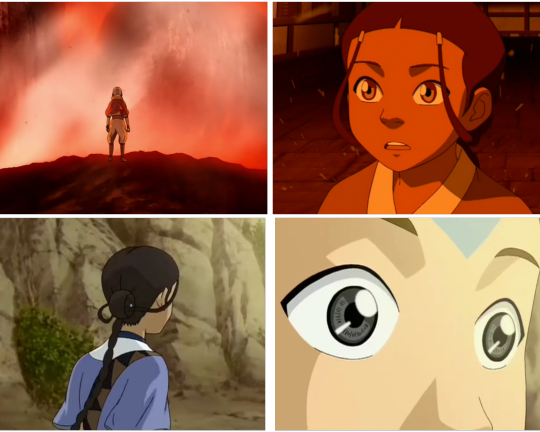
When analysing this aspect of Katara and Aang's relationship, I couldn't help but be reminded of how Célene Sciamma's Portrait of a lady on fire (in my personal opinion, one of the best studies of the female gaze ever created) builds up its romance, and how it places a strong emphasis on the mutuality of the female gaze.
Portrait of a lady on fire's cinematography is very important to the film. We see the world through the perspective of our protagonist, a painter named Marianne. We also see her love interest, Héloïse, the woman whom she is hired to paint a portrait of, through Marianne's lense.
We see Marianne analyse Héloïse's appearance, her beauty. We look purely through Marianne's eyes at Héloïse for a good part of the movie, but then, something unexpected happens. Héloïse looks back. At Marianne, therefore, in some way, also at the audience. While Marianne was studying Héloïse, Héloïse was studying Marianne.
We never shift into Héloïse's perspective, but we see and understand that she is looking back at us. Not only through her words, when she for example comments on Marianne's mannerisms or behaviours, but also hugely through cinematography and acting of the two amazing leads. (Noémie Merlant as Marianne and Adèle Haenel as Héloïse. They truly went above and beyond with their performances.)
This is a huge aspect of the female gaze's implementation in the film. The camera focuses on facial expressions, eyes and body language, seeking to convey the characters' emotions and feelings. There's a focus on intense, longing and reciprocated eye contact (I have dubbed this the Female Gays Gaze.). The characters stand, sit or lay facing each other, and the camera rarely frames one of them as taller than the other, which would cause a sense of power imbalance.
The best way to describe this method of flimaking is wanting the audience to see the characters, rather than to simply look at them. Sciamma wants us to empathise, wants us to feel what they are feeling, rather than view them from a distance. They are to be people, characters, rather than objects.
Avatar, of course, doesn't display the stunning and thoughtful cinematography of Portrait of a Lady on Fire, and Katara and Aang's relationship, while incredibly important, is only a part of the story rather than the focus of it.
However, the 'Kataang moments' we are privy to often follow a similar convention to the ones between Marianne and Héloïse that I mentioned prior.
Theres a lot of shots of Katara and Aang facing each other, close ups on their faces, particularly eyes, as they gaze at one another.
Katara and Aang are often posited as on equal grounds, the camera not framing either of them as much taller and therefore more powerful or important than the other. Aang is actually physically shorter than Katara, which flies in the face in usual conventions of the male fantasy. (I will get to Aang under the male gaze later in this essay)
And even in scenes when Aang is physically shown as above Katara, particularly when he's in the Avatar state, Katara is the one to pull him down, maintaining their relationships as equals.
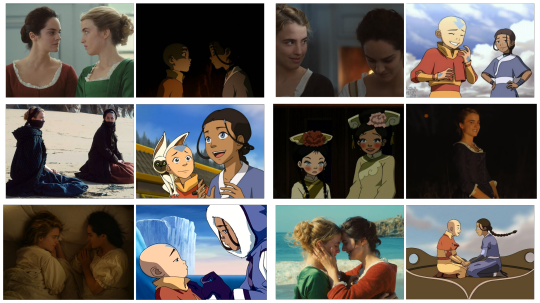
Despite most of the show being portrayed through Aang's eyes, Katara is not a passive object for his gaze, and therefore our gaze, to rest upon. Katara is expressive, and animated. As an audience, we are made aware that Katara has her own perspective. We are invited to take part in it and try to understand it.
Not unlike to Portrait of a Lady on Fire, there is a lot of focus placed on mannerisms and body language, an obvious example being Katara often playing with her hair around Aang, telegraphing a shy or flustered state. We also see her express jealousy over Aang, her face becoming sour, brows furrowed. On one occasion she even blew a raspberry, very clearly showing us, the audience, her displeasure with the idea of Aang getting attention from other girls.
Once again, this proves that Katara is not a passive participant in her own relationship, we are very clealry shown her perspective of Aang. Most of the scenes that hint at her and Aang's focus on their shared emotions, rather than, for example, Katara's beauty.
Even when a scene does highlight her physical appearance, it is not devoid of her own thoughts and emotions. The best example of this being the scene before the party in Ba Sing Se where we see Katara's looking snazzy in her outfit. Aang compliments her and Katara doesn't react passively, we see the unabashed joy light up her face, we can tell what she thinks of Aang's comment.
In fact, the first moment between Katara and Aang sets this tone of mutual gaze almost perfectly. Aang opens his eyes, and looks at Katara. Katara looks back.
There is, once again, huge focus on their eyes in this scene, the movement of Aang's eyelids right before they open draws out attention to that part of his face. When the camera shows us Katara, is zooms in onto her expression as it changes, her blinking also drawing attention to her wide and expressive eyes.

This will not be the first time emphasis is placed on Katara and Aang's mutual gaze during a pivotal moment in the show. Two examples off the top of my head would be the Ends of B2 and B3 respevtively. When Katara brings Aang back to life, paralleling the first time they laid eyes on one another. And at the end of the show, where their gaze has a different meaning behind it.
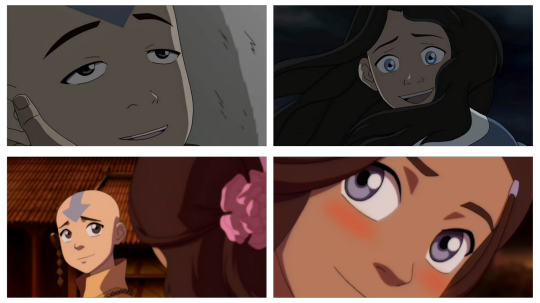
We see Katara's emotions and her intent telegraphed clearly in these instances.
In Book 1, we see her worry for this strange bald boy who fell out of an iceberg, which melts away to relief and a hint of curiosity once she ascertains that he isn't dead.
In B2 we once again see worry, but this time it's more frantic. Her relationship with Aang is much dearer to her heart now, and he is in much worse shape. When we see the relief on her face this time, it manifests in a broad smile, rather than a small grin. We can clearly grasp that her feelings for Aang have evolved.
In B3, we step away from the rule because Aang isn't on the verge of death or unconsciousness for the first time. It is also the first time in a situation like this that Aang isn't seeing Katara from below, but they are on equal footing. I attribute this to symbolising change of pace for their relationship.
The biggest obstacle in the development of Katara and Aang's romance was the war, which endangered both their lives. Due to this, there was a hesitance to start their relationship. In previous scenes that focused this much on Aang and Katara's mutual gaze, Aang was always in a near dead, or at least 'dead adjacent' position. This is is a very harsh reminder that he may very well die in the war, and the reason Katara, who has already endured great loss, is hesitant to allow her love for him to be made... corporeal.
However, now Aang is standing, portraying that the possibily of Katara losing him has been reduced greatly with the coming of peace, the greatest obstacle has been removed, and Katara is the one to initiate this kiss.
Concurrently, Katara's expression here does not portray worry or relief at all, because she has no need to be worried or relieved. No, Katara is blushing, looking directly at Aang with an expression that can be described as a knowing smile. I'd argue that this description is accurate, because Katara knows that she is about to finally kiss the boy she loves.
Ultimately, Katara is the one who initiates the kiss that actually begins her and Aang's romantic relationship.
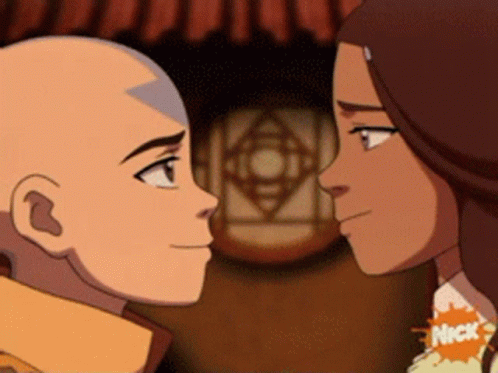
Kataang's appeal to women is reflected in how Katara is almost always the one to initiate physical affection with Aang. With only 3 exceptions, one of which, the Ember Island kiss being immediately shown by the narrative as wrong, and another being a daydream due to Aang's sleep deptivation. The first moment of outwardly romantic affection between Aang and Katara is her kissing his cheek. And their last kiss in the show is also initiated by Katara.
I won't falsely state that Kataang is the perfect representation of the female gaze. Not only because the storyline has its imperfections, as every piece of media has. But also because I simply belive that the concept of the female gaze is too varied and nebulous to be fully expressed. With this essay, I simply wanted to prove that Kataang is most certainly not the embodiment of catering to the male gaze either. In fact it is quite far from that.
The aspects of Kataang that fall more towards embodying the female gaze don't just appeal to women. There's a reason a lot of vocal Kataang shippers you find are queer. The mutual emotional connection between Katara and Aang is something we don't have to identify with, but something we are still able to emphasise with. It's a profound mutual connection that we watch unfold from both perspectives that sort of tracends more physical, gendered aspects of many onscreen romances. You just need to see instead of simply look.
✨️Bonus round✨️
Aang under the gaze
This started off as a simple part of the previous essay, however I decided I wanted to give it it's own focus, due to the whole discourse around Aang being a wish-fullfilling self insert for Bryke or for men in genral. I always found this baffling considering how utterly... unappealing Aang is to the male gaze.
It may surprise some of you that men are also subjected to the male gaze. Now sadly, this has nothing to do with the male gaze of the male gays. No, when male characters, usually the male protagonist, are created to cater to the male gaze, they aren't portrayed as sexually desirable passive objects, but they embody the active/masculine aide of the binary Laura Mulvey spoke of in the quote I shared at the beginning of this essay.
The protagonist under the male gaze is not the object of desire but rather a character men and boys would desire to be.
They're usually the pinnacle of traditional, stereotypical masculinity.
Appearance wise: muscular but too broad, chiseled facial features, smouldering eyes, depending on the genre wearing something classy or some manner of armour.
Personalitywise they may vary from the cool, suave James Bond type, or a more hotblooded forceful "Alpha male" type. However these are minor differences in the grand scheme of things. The basis is that this protagonist embodies some manner of idealised man. He's strong, decisive, domineering, in control, intimidating... you get the gist. Watch nearly any action movie. There's also a strong focus placed on having sway or power over others. Often men for the male gaze are presented as wealthy, having power and status. Studies (that were proved to be flawed in the way the data was gathered, I believe) say that womem value resources in potential male partners, so it's not surprising that the ideal man has something many believe would attract "mates". [Ew I hated saying that].
Alright, now let's see how Aang holds up to these standards.

Well... um...
Aang does have power, he is the Avatar. However, he is often actually ignored, blown off and otherwise dismissed, either due to his age or his personality and ideals being seen as unrealistic and foolish. Additionally, Aang, as a member of a culture lost a century ago, is also often posited as an outsider, singled out as weak, his beliefs touted as the reason his people died out and.
Physically, Aang doesn't look like the male protagonist archetype, either. He isn't your average late teens to brushing up against middle aged. Aang is very much a child and this is reflected in his soft round features, large eyes and short, less built body. This is not a build most men would aspire to. Now, he still has incredible physical prowess, due to his bending. But I'm not sure how many men are desperate to achieve the "pacifist 12 year old" build to attract women.
Hailing from a nation that had quite an egalitarian system, Aang wouldn't have conventional ideas surrounding leadership, even if he does step up into it later. He also has little in the way of possessions, by choice.
As for Aang's personality, well...

I mean I wouldn't exactly call him your average James Bond or superhero. Aang is mainly characterised through his kindness, empathy, cheerful nature and occasional childishness (which slowly is drained as the trauma intesifies. yay.)
Aang is very unwilling to initiate violence, which sets him aside from many other male protagonists of his era, who were champing at the bit to kick some ass. He values nature, art, dance and fun. He's in tune with his emotions. He tries to desecalate situations before he starts a fight.
Some would say many of Aang's qualities could be classified as feminine. While the other main male characters, Zuko and Sokka try to embody their respective concepts of the ideal man (tied to their fathers), Aang seems content with how he presents and acts. He feels no need to perform masculinity as many men do, choosing to be true to his emotions and feelings.
These "feminine" qualities often attract ridicule from other within the show. He is emasculated or infantiliased as a form of mockery multiple times, the most notable examples being the Ember Island play and Ozai tauntingly referring to him as a "little boy". Hell, even certain Aang haters have participated in this, for example saying that he looks like a bald lesbian.
I'd even argue that, in his relationships with other characters, Aang often represents the passive/feminine. Especially towards Zuko, Aang takes on an almost objectified role of a trophy that can be used to purchase Ozai's love. [Zuko's dehumanisation of others needs to be discussed later, but it isn't surprising with how he was raised and a huge part of his arc is steerring away from that way of thinking.]
Aang and Zuko almost embody certain streotypes about relationships, the forceful, more masculine being a literal pursuer, and the gentler, more feminine being pusued.
We often see Aang framed from Zuko's perspective, creating something akin to the mutual gaze of Katara and Aang, hinting at the potential of Zuko and Aang becoming friends, a concept that is then voiced explicitly in The Blue Spirit.
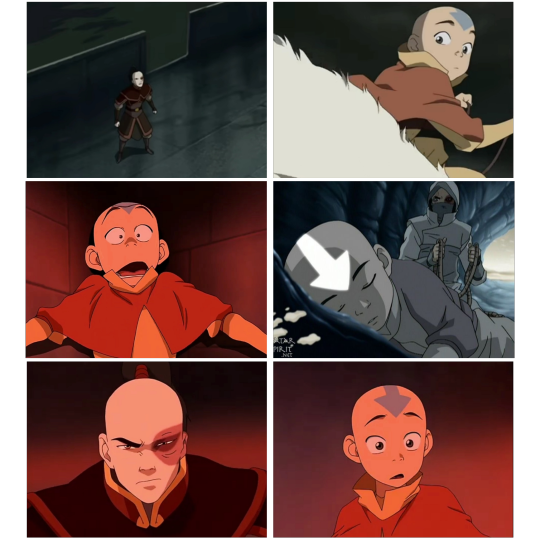
However, unlike Katara, Zuko is unable to empathise with Aang at first, still seeing Aang as more of an object than a person. We have here an interesting imbalance of Aang seeing Zuko but Zuko meerly looking at Aang.
There is a certain aspect of queer metaphor to Zuko's pursuit of Aang, but I fear I've gotten off topic.
Wrapping this long essay up, I want to reiterate that I'm not saying that Zutara isn't popular with women. Most Zutara shippers I've encountered are women. And most Kataang shippers I've encountered are... also women. Because fandom spaces are occupied predominantly by women.
I'm not exactly making a moral judgement on any shippers either, or to point at Kataang and go: "oh, look girls can like this too. Stop shipping Zutara and come ship this instead."
I want to point out that the juxtaposition of Zutara and Kataang as respectively appealing to the feminine and masculine, is a flawed endeavour because neither ship does this fully.
The concept of Kataang being a purely male fantasy is also flawed due to the points I've outlied in this post.
Are there going to be male Kataang shippers who self insert onto Aang and use it for wish fulfilment? Probably. Are there going to be male Zutara shippers who do the same? Also probably.
In the end, our interpretation of media, particularly visual mediums like film are heavily influenced by our own biases, interests, beliefs andmost importantly our... well, our gaze. The creators can try to steer us with meaningful shots and voiced thought, directing actors or animating a scene to be a certain way, but ultimately we all inevitably draw our own conclusions.
A fan of Zutara can argue that Kataang is the epitome of catering to the male gaze, while Zutara is the answer to women everywhere's wishes.
While I can just as easily argue the exact opposite.
It really is just a matter of interpretation. What is really interesting, is what our gaze says about us. What we can see of ourselves when the subject gazes back at us.
I may want to analyse how Zutara caters to the male gaze in some instances, if those of you who manage to slog through this essay enjoy the subject matter.
#ok getting off my soapbox#i forgot how much i love to write these long sprawling essays...#kataang#pro kataang#aang#pro aang#aanglove#aang defense squad#pro katara#katara defense squad#kataang love#zuko#avatar#atla#avatar: the last airbender#the last airbender#avatar the last airbender#aang the last airbender#anti zutara
432 notes
·
View notes
Text

actually going insane from this take. holy shit.
It's one thing to point out that Katara and Zuko losing their mom in a traumatic way is something specific they have in common (note how Sokka is never included there either, despite literally having the same mother as his sister). It's another to invalidate and downplay Aang's loss of his ENTIRE RACE AND CULTURE just to boost your ship. He literally says in the show that he knows how Katara feels because of his loss. He's been depicted entering the same pain-induced anger as Katara has.
Not to mention, Aang and Katara have that to bond over too - as her culture has been decimated by the very same people that killed Aang's. Zuko's people, by the way.
Lastly it's just blatantly untrue and frankly insulting to say that Aang "got over" the genocide of his people "in one season" (given that it's mentioned in every season and plays an important role to Aang's character each time). This isn't something one can "get over". It's very likely that Aang will never recover from this. And it's disgusting to say that he hasn't been cut as deeply just because he doesn't mention it every 5 seconds and rage about it.
#op made a whole ass essay defending zutara and this they thought this was a good point to make#instead of making them look like an insensitive pos incapable of reading between the lines#and feeling empathy#aang#katara#zuko#anti zutara#atla
566 notes
·
View notes
Text
popular fandom: Katara does all the chores and emotional labour around camp, no one ever helps her (except Zuko) and she just suffers in silence!!
actual canon:












and most of all, from Katara's actual goddamn mouth:






but yeah Zuko serving the gaang tea two (2) times (which is mostly about his relationship with Iroh obviously, given that both times his connection to Uncle is highlighted in dialogue or in action) clearly disregards all of the above
#like we see katara cook the most but like. that's it fam#atla#katara#anti zutara#antizutara#it's like my least favourite fanon take like. are yall GOOD#also how aang always uses himself as the distraction / shield for the good of the group my beloved#clowns on this post will get blocked
441 notes
·
View notes
Text
I bring a sort of 'Men and by extension male characters deserve to be praised for going above and beyond for their female love interests,not doing the bare minimum or even actively treating them badly but changing their minds once they realize they want to date them and the latter is actually more male entitlement than enemies to lovers' vibe to fandoms that fake toxic masculinity haters don't really like
#ichigo kurosaki#orihime inoue#ichihime#todoroki shouto#momo yaoyorozu#todomomo#izuku midoriya#uraraka ochako#izuocha#anti bakugou#anti kylo ren#anti reylo#anti booktok#anti zutara#katara#aang#kataang#miles morales#hobie brown#gwen stacy#ghostflower#ghostpunk#ghostpunkflower#black gwen stacy#trans gwen stacy#anti miraculous ladybug#tim drake#jason todd#💌#summerposting
193 notes
·
View notes
Text

Mind you, these are the people who say that zutara is a “female gaze”
190 notes
·
View notes
Text

We know
Except on tumblr and TikTok
904 notes
·
View notes
Text
One thing I am SICK of is atla fans especially z*tara fans making Zuko the cool tough bad boy and Katara being the sweet innocent nerd
NO
Katara is the cool smart bad girl who probably knows how to ride a motorcycle and Aang is her cute pacifist boyfriend
#atla#Katara atla#Kataang#aang atla#anti Zutara#anti zutara stans#pro kataang#Kataang atla#pro katara#pro aang#katara x aang#avatar: the last airbender#avatar the last airbender
197 notes
·
View notes
Text
I think almost all of the anti Mai discourse from namely Zutara shippers boils down to this.
You can try and deliberately misconstrue the writing to say Zuko forgot Mai, was never happy around her, never loved her, etc etc
But not once can you say Zuko ever looked at Katara, Jin, or any other female character you ship him with the same way he looks at Mai in these four panels.




What I love about the art of animation is it conveys so much when words can’t.
The eyes, Chico. They never lie.
This single scene conveys so much love, adoration, and the happiness of finally reuniting with your soulmate. And no amount of dissertations on how a fanon ship would’ve made a children’s tv show more enjoyable to you will never change that.
The curse of canon weighs on Maiko and Kataang shippers, but we wouldn’t have it any other way.
395 notes
·
View notes
Text
i love how the runaway episode tells us that katara does not like to be perceived as motherly. and what do people do? perceive everything she does as motherly. except when she's with zuko, of course
this poor girl will never be free
417 notes
·
View notes